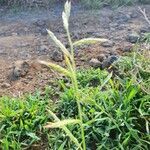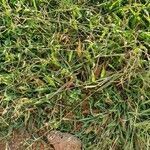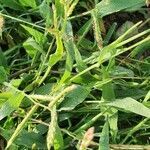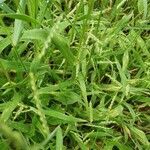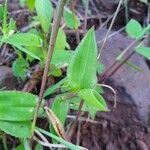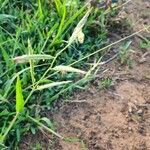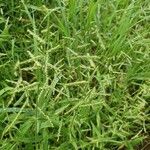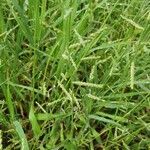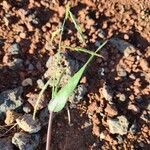Annual. Culms loosely tufted, geniculately ascending, 20–80 cm tall, nodes bearded. Leaf sheaths loose, with tubercle-based setae, one margin densely ciliate; leaf blades linear-lanceolate, 5–15(–20) × 0.5–1.5 cm, glabrous to thinly pilose, margins pectinate-ciliate at least toward amplexicaul base, apex acuminate; ligule 1.5–2 mm. Inflorescence axis 3–6 cm; racemes 3–10, 2–6 cm, stiff, diverging; rachis flattened, setose mainly from the short stout pedicels; spikelets usually borne singly or in pairs at base, occasionally mostly paired, overlapping by ca. 1/3 their length. Spikelets ovate-elliptic, 4–5 mm, glabrous or pubescent, cuspidate; lower glume ovate,1/4–1/3 spikelet length, 3–5-veined, obtuse; upper glume 5–9-veined with evident cross veins; upper lemma rugose, mucro 0.4–1 mm. Fl. and fr. Sep–Oct.
Tufted erect or prostrate annual, 100-900 mm high; often spreading cartwheel-like. Leaf blade 20-250 x 5-18 mm; ligule a fringed membrane to a fringe of hairs. Inflorescence of 2-7(-10), secund racemes, 10-90 mm long, scattered alternately on a central axis. Spikelets (2.5-)3.5-4.5(-5.5) mm long, dorsiventrally compressed, elliptic; glumes unequal, dissimilar; lower glume < 1/2 as long as spikelet (rarely longer), apex broadly rounded or truncate, 3-5-nerved; upper glume 9-nerved, cross-veins often present, glabrous or pubescent. Florets 2; lower floret male or sterile, lemma sometimes with a fringe of stiff hairs near margins; upper floret bisexual, lemma indurated, rugulose, entire, awn 0.3-1.0 mm long, shorter than spikelet; anther 0.9-2.0 mm long. Flowering time Oct.-May.
Tufted erect or prostrate annual 100-900 mm high; often spreading cartwheel-like; basal sheaths glabrous to densely hairy, rarely splitting into fibres. Leaf blade 20-250 x 5-18 mm. Inflorescence of 2-7(-10) racemes, 10-90 mm long. Spikelet (2.5-)3.5-4.5(-5.5) mm long, elliptic; lower glume less than 1/2 as long as spikelet (rarely longer), without stiff hairs on the back, apex broadly rounded or truncate; upper glume 9-nerved, cross-veins often present, glabrous or pubescent; lower lemma sometimes with a fringe of stiff hairs near the margins; upper lemma rugulose, awn 0.3-1.0 mm long; anther 0.9-2.0 mm long.
Annual; up to 0.9 m high; tufted. Culms erect or procumbent; often spreading cartwheel-like. Leaf blades 20-250 x 5-18 mm. Flowers: in spaced; digitate inflorescences; racemes 2-7(-10); 10-90 mm long; spikelets (2.5-)3.5-4.5(-5.5) mm long; lower glume 1/3 as long as spikelet; upper glume 9-nerved; cross-veins often present on upper glume and lemmas; awn on upper lemma 0.3-1.0 mm long.
Annual, tufted (erect or prostrate, often spreading cartweel-like), up to 0.9 m high. Leaf blades 20-250 mm long, 5-18 mm wide. Spikelets (2.5-)3.5-4.5(-5.5) mm long. Inflorescence of 2-7(-10) racemes, 10-90 mm long; lower glume less than half the spikelet length; cross-veins often present on upper glume and lemmas; awn on upper lemma 0.3-1.0 mm long.
Inflorescence of 2–7 (rarely more) racemes, these 1–7 cm. long bearing single or sometimes paired spikelets on a narrowly winged rhachis, the pedicels (rarely also the rhachis) with long white hairs.
An annual grass. It forms loose tufts. It is 20-80 cm tall. The leaf sheaths are loose. The blades are sword shaped and 5-15 cm long by 0.5-1.5 cm wide.
Inferior glume 1/4–1/3(1/2) length of spikelet, ovate, 3–5 nerved. Superior glume usually with cross nerves.
Inferior lemma usually with cross nerves. Superior lemma rugulose, with a mucro 0.3–1.3 mm. long.
Leaf laminae linear to narrowly lanceolate, subamplexicaul, coarse, glabrous or pubescent.
Spikelets (2.5) 3.5–4.5 (5.5) mm. long, elliptic, glabrous, pubescent or setosely fringed.
Culms 10–100 cm. high, often ascending from a prostrate rooting base.
Annual.
